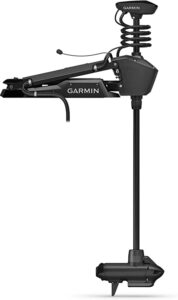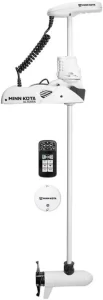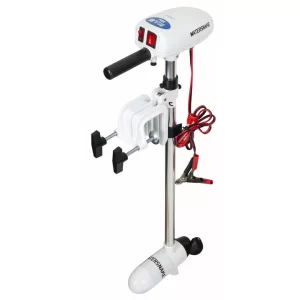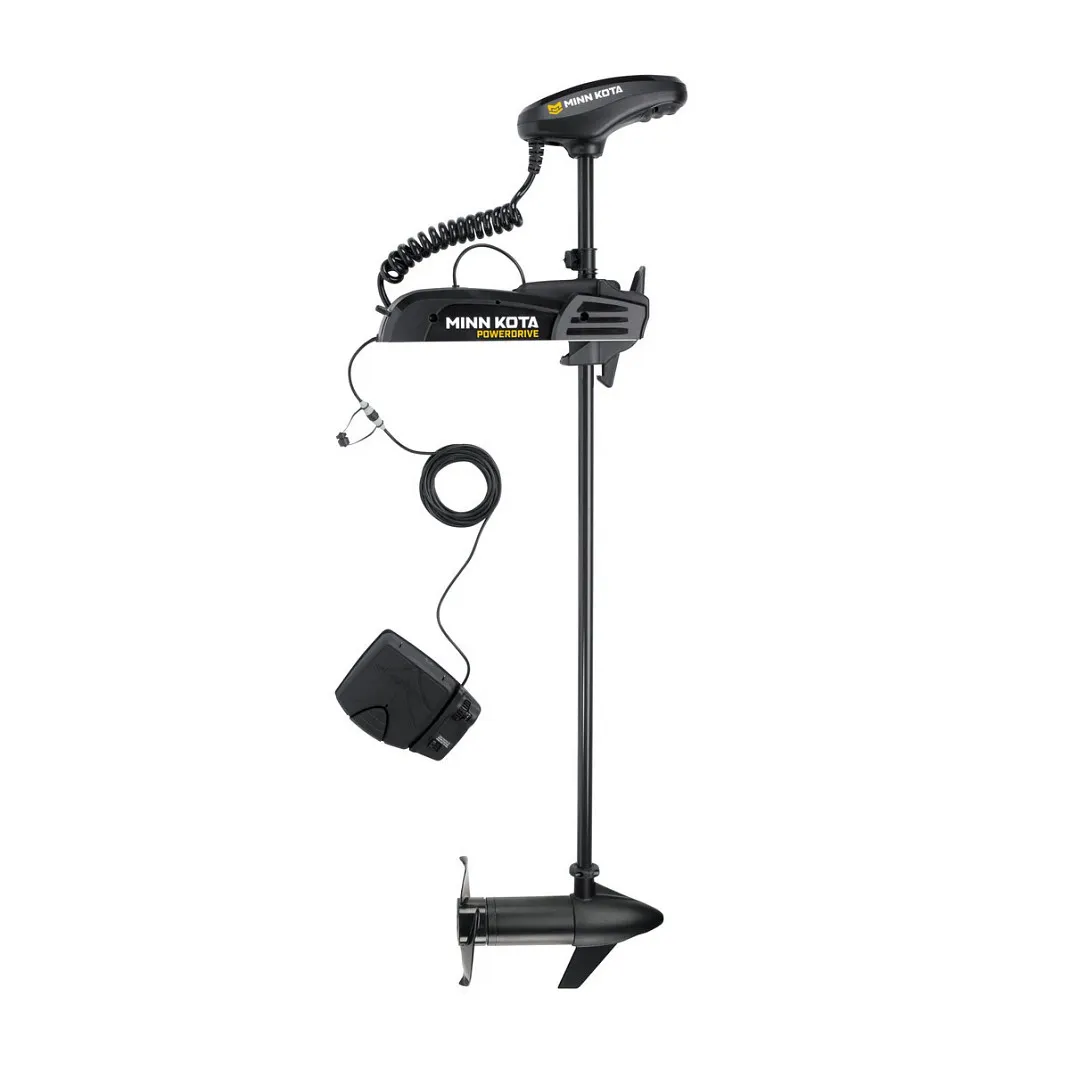| Garmin Force Trolling Motor | Minn Kota Riptide Ulterra | Watersnake Asp Saltwater Trolling Motor |
|---|---|---|
 |
 |
 |
| Water Compatibility: Freshwater, saltwater, and brackish | Water Compatibility: Saltwater | Water Compatibility: Saltwater |
| Thrust: 80 lbs., 100 lbs. | Thrust: 80 lbs / 112 lbs | Thrust: 18 lbs / 24 lbs |
| Voltage: 24 V / 36 V | Voltage: 24V / 36V | Voltage: 12 V |
| Speed Control: 20 power settings | Speed Control: Variable | Speed Control: 2-forward, 2-reverse (low/high) |
| Control Type: Wireless foot pedal; handheld remote | Control Type: Foot pedal/i-Pilot wireless remote/app | Control Type: Hand-tiller |
| Mount Type: Bow | Mount Type: Bow | Mount Type: Transom/Kayak |
| Shaft Length: 50", 57" | Shaft Length: 54" / 60" / 72" | Shaft Length: 24" |
| Shaft Material: Fiberglass | Shaft Material: Composite | Shaft Material: Alloy |
| Propeller Type: Garmin High-Efficiency Propeller (2 blades) | Propeller Type: Weedless Wedge 2 | Propeller Type: 2-blade |
| Battery Capacity: Dependent on usage | Battery Capacity: N/A | Battery Capacity: Varies |
| Maximum Amp Draw: 57 amps, 54 amps | Maximum Amp Draw: 52A / 56A | Maximum Amp Draw: 15A / 20A |
| Warranty: 3-year warranty; limited lifetime warranty on the shaft | Warranty: 2-years - lifetime for shaft | Warranty: 1-year |
| Spot Lock: Yes | Spot Lock: Yes | Spot Lock: No |
| Fish Finder Connectivity: Yes | Fish Finder Connectivity: Yes (through i-Pilot Link and One-Boat Network) | Fish Finder Connectivity: No |
| Best Price (Amazon) | Best Price (Amazon) Best Price (Bass Pro) | Best Price (Amazon) |
CORROSION RESISTANCE
When looking for maximum corrosion and saltwater protection, the Minn Kota Riptide Ulterra leads the pack. It starts with an indestructible composite shaft that shrugs off salt, UV rays, and underwater scrapes. The multi-piece polymer bracket system eliminates metal mounting hardware prone to corrosion.
The entire head unit and foot pedal system are fully encased in a tough composite shell to block moisture and salt intrusion. Stainless steel internal parts resist rusting and wear in all saltwater conditions. Even the wiring is designed for marine use.
Minn Kota pulls no punches when it comes to their "salt armor" construction that fortifies the Riptide series against corrosion. Rest assured it can withstand years of saltwater usage and maintain flawless performance. If you demand a saltwater trolling motor built to thrive in oceans, the Riptide Ulterra delivers.
DURABILITY
When it comes to unmatched ruggedness and durability, the Garmin Force trolling motor ranks at the top. Starting with an indestructible fiberglass composite shaft, this motor can handle constant underwater abuse. The flexible composite helps absorb impacts other shafts would transmit directly to sensitive electronics.
Garmin reinforces the composite head and all connections with metal sleeves and extensive sealants. Marine grade metals, bearings, and composites ensure every component stands up over time. Even the wiring harness uses abrasion resistant trolling motor cable.
Simply put, the Garmin Force saltwater trolling motor is engineered without compromise for extreme durability and resilience in all conditions. It has the brawn and grit to keep running year after year. When durability is priority one, the Force delivers in spades.
THRUST
Despite its incredibly compact size, the Watersnake ASP saltwater trolling motor packs a surprising punch when it comes to thrust. With 30 and 40 pound thrust options from its small 5 pound composite body, this motor generates impressive pushing power.
The key is a high efficiency prop design that maximizes every ounce of thrust from the motor. Watersnake utilizes a custom composite weedless prop optimized for both power and remaining debris-free. Reinforced composite materials throughout ensure the housing withstands high RPM operation.
Simply put, the Watersnake ASP saltwater motor squeezes every bit of potential from its small motor. The thrust rivals much larger units thanks to thoughtful design and construction. When you need big power in a tiny package, this little motor packs a serious punch.

Selecting the ideal saltwater trolling motor is a critical decision for ocean anglers. Saltwater motors need to withstand constant exposure to salt, UV rays, underwater obstacles, and other harsh marine conditions. They require specialized construction to avoid corrosion and remain durable long-term.
In this comprehensive guide, we’ll cover the key factors to evaluate when selecting the best saltwater trolling motor for your offshore needs.
The number one priority in a saltwater trolling motor is comprehensive corrosion resistance. Salt, humidity, water, UV rays, and underwater debris will quickly corrode lesser motors. That's why robust anti-corrosion measures are essential.
Look for motors featuring an indestructible composite fiberglass or thermoplastic shaft. These shrug off the elements and impacts. Composite housing, mounting, and components also prevent oxidation and rotting from moisture.
Stainless steel metals, marine-grade aluminum alloys, and sealed connections prevent rust and deterioration. The best saltwater motors have comprehensive protections like Minn Kota's "salt armor" coatings inside and out.
Don’t settle for half-measures when it comes to corrosion resistance—the marine environment demands next level fortification. Seek out purpose-built saltwater motors engineered to keep the salt out.
In addition to corrosion resistance, durability is paramount in the rough marine domain. Trolling motors endure constant scrapes, bumps, UV exposure, and pressure. They must be crafted to handle years of abuse.
A nearly indestructible composite shaft flexes to absorb impacts rather than transmitting them to fragile electronics. Look for reinforced composite housing and head assemblies rather than cheap plastics prone to cracking.
All connections should be over-engineered with robust metals and abundant sealants. Bearings, bushings, and other internal parts must be marine-grade to resist wear.
Simply put, all components need to be over-built for the marine environment. When shopping, inspect the motor for robust parts at every point—offshore demands next level durability.
Don't handicap your offshore boat with inadequate thrust. Look for 80, 100, 112 lb or higher max thrust to power through currents, swells, and winds offshore. High torque brushless motors also deliver excellent power efficiently.
Higher thrust matches the larger, heavier boats designed for blue water fishing. It also compensates for increased resistance and draw when running offshore. More thrust equals more speed, control, and versatility offshore.
That said, don't go overboard and choose far more thrust than your boat needs—it wastes battery life and can make steering overly sensitive. Right-size the power, but when in doubt, go a bit higher for offshore applications.
When venturing offshore, using a purpose-built saltwater trolling motor is imperative. Seek out motors with comprehensive corrosion resistance and extreme-duty construction to withstand years of marine use. Carefully match thrust to your boat's size and target usages.
Choosing the ideal saltwater trolling motor allows you to fish confidently anywhere offshore knowing it will perform reliably for the long haul. Don't compromise when it comes to withstanding the harsh offshore environment.
For offshore boats, 80 pounds of thrust or more is recommended. Larger center console boats and blue water vessels need 100+ pounds of thrust. The extra power helps overcome currents, wind, and waves to keep you on track offshore. But don't overpower small boats with excessive thrust that makes steering overly touchy. Carefully match the thrust to your boat's size and typical load to optimize open water performance.
Choose motors with full composite casings like Minn Kota's "salt armor" coating to shield electronics from moisture and corrosion. Any exposed connections should be heavily sealed and fortified. Stainless steel components resist oxidation. Quickly rinse the motor with freshwater after each trip. Remove the head unit when trailering to allow air circulation. Keep the foot pedal control out of standing water in the boat. Take every precaution to keep salt away from the electronics.
Composite fiberglass or thermoplastic polymer shafts are ideal for saltwater. The composite material resists corrosion far better than steel or aluminum and is also more durable. Composites flex to absorb impacts rather than cracking or bending like metal. They maintain strength despite years of UV exposure and saltwater damage. Quality brands like Minn Kota and Motorguide build their saltwater shafts from nearly indestructible composite.